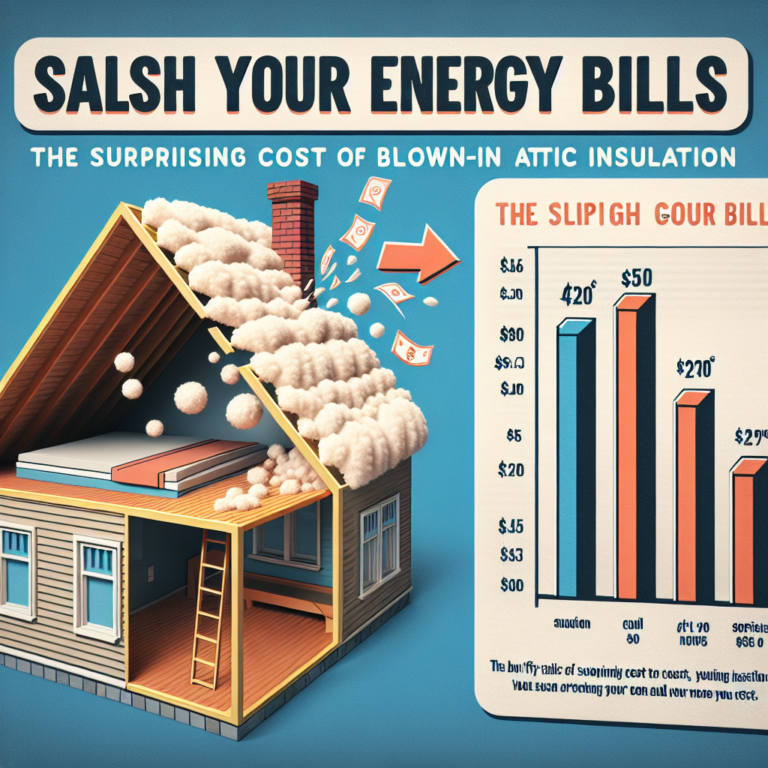-
Table of Contents
Upgrade your walls with blown-in insulation for superior insulation performance.
“Upgrade your home’s wall insulation with blown-in insulation for improved performance. Visit texasinsulationsolution.com to learn more and schedule your installation today!”
Introduction
Blown-in insulation is a popular method for improving wall insulation performance in homes and buildings. This technique involves using loose insulation materials, such as fiberglass or cellulose, and blowing them into wall cavities or attics using specialized equipment. This creates a dense layer of insulation that helps to reduce heat loss and improve energy efficiency. Blown-in insulation is known for its effectiveness in filling small gaps and crevices, providing a more complete and thorough insulation solution compared to traditional methods. In this way, it can greatly enhance the overall insulation performance of a structure, leading to increased comfort and cost savings for homeowners and building owners.
Benefits of Blown-In Insulation for Wall Insulation Performance
Insulation is an essential component of any building, as it helps to regulate the temperature and keep the interior comfortable. While most people are familiar with traditional forms of insulation, such as batt or roll insulation, there is another option that is gaining popularity – blown-in insulation. This type of insulation involves blowing loose fibers or particles into the wall cavities, creating a dense layer of insulation. In this article, we will explore the benefits of blown-in insulation for wall insulation performance.
One of the main advantages of blown-in insulation is its ability to fill in small gaps and crevices that may be missed by other forms of insulation. This is especially important for wall insulation, as walls often have uneven surfaces and hard-to-reach areas. The loose fibers of blown-in insulation can easily conform to these spaces, creating a more complete and effective barrier against heat transfer.
Furthermore, blown-in insulation is known for its high R-value, which is a measure of its thermal resistance. This means that it is highly effective at preventing heat from escaping or entering a building. In fact, blown-in insulation has been found to have a higher R-value per inch than other types of insulation, making it a more efficient choice for wall insulation.
Another benefit of blown-in insulation is its ability to reduce air leakage. Air leakage occurs when there are gaps or cracks in the walls, allowing air to flow in and out of the building. This can lead to drafts, uneven temperatures, and higher energy bills. Blown-in insulation can help to seal these gaps and reduce air leakage, creating a more comfortable and energy-efficient environment.
In addition to its thermal and air sealing properties, blown-in insulation also has soundproofing capabilities. The loose fibers of blown-in insulation can absorb sound waves, reducing noise transfer between rooms and from outside. This is particularly beneficial for homes or buildings located in noisy areas, as it can create a more peaceful and quiet interior.
Moreover, blown-in insulation is a more environmentally friendly option compared to other forms of insulation. It is often made from recycled materials, such as shredded newspaper or cellulose fibers, making it a sustainable choice for insulation. Additionally, the installation process of blown-in insulation produces less waste compared to other forms of insulation, as it does not require cutting or trimming to fit into wall cavities.
One of the most significant benefits of blown-in insulation for wall insulation performance is its ability to improve energy efficiency. By creating a more effective barrier against heat transfer, blown-in insulation can help to reduce the amount of energy needed to heat or cool a building. This, in turn, can lead to lower energy bills and a more sustainable living or working space.
Furthermore, blown-in insulation can also help to extend the lifespan of a building. By reducing air leakage and preventing moisture from entering the walls, it can help to prevent mold growth and structural damage. This can save homeowners and building owners from costly repairs in the long run.
In conclusion, blown-in insulation offers numerous benefits for wall insulation performance. Its ability to fill in small gaps, high R-value, air sealing and soundproofing properties, sustainability, and energy efficiency make it a superior choice for wall insulation. Whether you are building a new home or looking to upgrade your current insulation, consider blown-in insulation for improved wall insulation performance.
The Attic Installation Process for Blown-In Insulation in Houston
Blown-in insulation is a popular method for improving the insulation performance of walls in homes and buildings. This technique involves using a machine to blow loose insulation material into wall cavities, creating a dense layer that helps to reduce heat transfer and improve energy efficiency. In Houston, where hot and humid weather is a constant, blown-in insulation is a highly recommended solution for homeowners looking to lower their energy bills and increase the comfort of their living spaces.
The attic is often the first place to start when it comes to blown-in Insulation Installation in Houston. This is because the attic is one of the main areas where heat can escape or enter a home, making it a crucial space to insulate properly. The process of installing blown-in insulation in the attic involves several steps that must be followed carefully to ensure optimal performance.
The first step in the attic installation process is to prepare the space. This involves clearing out any existing insulation, debris, or obstructions that may be present. It is important to have a clean and clear space to work with to ensure that the insulation is evenly distributed and properly installed. Any gaps or holes in the attic should also be sealed to prevent air leakage, which can compromise the effectiveness of the insulation.
Once the attic is prepared, the next step is to determine the type and amount of insulation needed. The most common types of blown-in insulation used in Houston are fiberglass and cellulose. Fiberglass insulation is made of tiny glass fibers and is known for its durability and resistance to moisture. Cellulose insulation, on the other hand, is made of recycled paper and is treated with fire-retardant chemicals for added safety. Both types of insulation have their own advantages, and the choice ultimately depends on the homeowner’s preference and budget.
After the type of insulation is chosen, the installation process begins. A machine is used to blow the insulation material into the attic, filling the space between the joists and creating a thick layer of insulation. This process requires skill and precision to ensure that the insulation is evenly distributed and reaches all areas of the attic. Professional installers are trained to handle the machine and can complete the job efficiently and effectively.
One of the main benefits of blown-in insulation is its ability to fill in small gaps and crevices that other types of insulation may not be able to reach. This is especially important in older homes where there may be uneven or irregularly shaped wall cavities. The blown-in insulation can conform to these spaces, creating a tight seal and preventing air leakage.
Another advantage of blown-in insulation is its ability to resist moisture. In Houston’s humid climate, this is crucial as moisture can lead to mold and mildew growth, causing health hazards and damage to the home. The dense layer of insulation created by blown-in insulation helps to prevent moisture from seeping into the walls and attic, keeping the home dry and safe.
In conclusion, blown-in insulation is an effective and efficient way to improve the insulation performance of walls in Houston homes. The attic installation process involves preparing the space, choosing the type of insulation, and using a machine to blow the material into the attic. This method provides a tight seal, fills in small gaps, and resists moisture, making it a highly recommended solution for homeowners looking to improve their home’s energy efficiency and comfort. With professional installation and proper maintenance, blown-in insulation can provide long-lasting benefits for homeowners in Houston.
How Blown-In Insulation Outperforms Traditional Wall Insulation Methods
Insulation is an essential component of any building, as it helps to regulate the temperature and keep the interior comfortable. When it comes to wall insulation, there are various methods available, but one that has been gaining popularity in recent years is blown-in insulation. This method involves using loose insulation material, such as fiberglass or cellulose, and blowing it into the walls using specialized equipment. While traditional methods of wall insulation, such as batt or roll insulation, have been used for decades, blown-in insulation offers several advantages that make it a superior choice. In this article, we will explore how blown-in insulation outperforms traditional wall insulation methods.
One of the main advantages of blown-in insulation is its ability to fill in gaps and voids in the wall cavity. Unlike batt or roll insulation, which can leave gaps and spaces between the insulation and the wall, blown-in insulation can be evenly distributed and fill in all the nooks and crannies. This ensures that there are no areas of the wall that are left uninsulated, providing maximum energy efficiency. Additionally, blown-in insulation can be installed around obstacles, such as pipes and wiring, without compromising its effectiveness. This makes it a great option for older homes with irregular wall cavities.
Another benefit of blown-in insulation is its superior R-value. R-value is a measure of an insulation material’s ability to resist heat flow, and the higher the R-value, the better the insulation performance. Blown-in insulation has a higher R-value compared to traditional methods, meaning it provides better thermal resistance and can keep the interior of a building warmer in the winter and cooler in the summer. This can result in significant energy savings and lower utility bills.
Furthermore, blown-in insulation is a more environmentally friendly option compared to traditional methods. Most blown-in insulation materials are made from recycled materials, such as shredded newspaper or recycled glass. This not only reduces waste but also reduces the need for new materials to be produced. Additionally, blown-in insulation does not contain any harmful chemicals, making it a safer choice for both the environment and the occupants of the building.
One of the most significant advantages of blown-in insulation is its ability to reduce air leakage. Air leakage occurs when there are gaps or cracks in the walls, allowing air to escape or enter the building. This can result in drafts, uneven temperatures, and higher energy bills. Blown-in insulation can effectively seal these gaps and cracks, reducing air leakage and improving the overall energy efficiency of a building. This also means that the interior of the building will be more comfortable, with fewer drafts and temperature fluctuations.
Moreover, blown-in insulation is a more cost-effective option compared to traditional methods. While the initial cost of installation may be slightly higher, the long-term savings on energy bills make it a worthwhile investment. Additionally, blown-in insulation can be installed quickly and easily, reducing labor costs. It also has a longer lifespan compared to traditional methods, meaning it will not need to be replaced as frequently, further reducing costs in the long run.
In conclusion, blown-in insulation offers several advantages that make it a superior choice for wall insulation. Its ability to fill in gaps and voids, higher R-value, environmental friendliness, and ability to reduce air leakage make it a more efficient and cost-effective option compared to traditional methods. If you are considering insulating your walls, it is worth considering blown-in insulation for its superior performance and long-term benefits.
Q&A
1. What is blown-in insulation?
Blown-in insulation is a type of insulation material that is installed by blowing it into walls, attics, or other spaces using specialized equipment. It is typically made of small particles of materials such as fiberglass, cellulose, or mineral wool.
2. How does blown-in insulation improve wall insulation performance?
Blown-in insulation improves wall insulation performance by filling in gaps and voids in the wall cavity, creating a more complete and continuous layer of insulation. This helps to reduce air leakage and heat transfer, making the walls more energy efficient and improving overall insulation performance.
3. What are the benefits of using blown-in insulation?
Some benefits of using blown-in insulation include improved energy efficiency, reduced heating and cooling costs, better soundproofing, and increased comfort in the home. It is also a more environmentally friendly option as it is made from recycled materials and can be easily installed without causing damage to existing walls or structures. Additionally, blown-in insulation is known for its ability to resist mold and mildew growth, making it a healthier choice for indoor air quality.
Conclusion
In conclusion, blown-in insulation is a highly effective method for improving wall insulation performance. It fills in gaps and voids in the wall, creating a seamless layer of insulation that helps to prevent heat loss and improve energy efficiency. This type of insulation also has a high R-value, meaning it can effectively resist heat flow and keep the interior of a building at a comfortable temperature. Additionally, blown-in insulation is easy to install and can be used in various types of walls, making it a versatile option for improving overall insulation performance. Overall, blown-in insulation is a cost-effective and efficient solution for enhancing the energy efficiency and comfort of a building.






